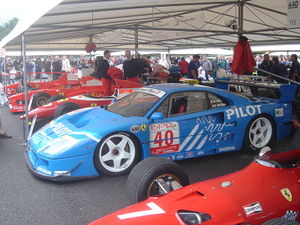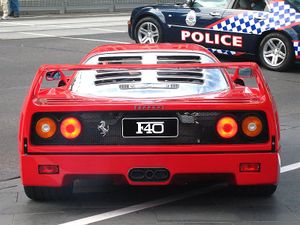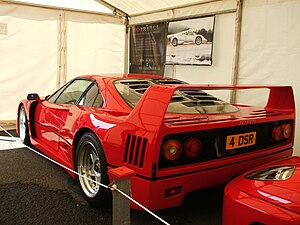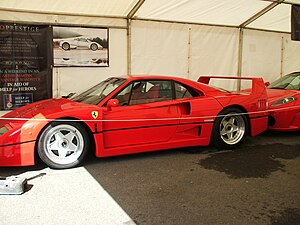Difference between revisions of "Ferrari F40"
m |
|||
| (14 intermediate revisions by the same user not shown) | |||
| Line 1: | Line 1: | ||
| − | {| border=1 | + | {{X}} |
| − | |colspan=2|[[Image: | + | {| border=1 cellspacing=3 cellpadding=4 style="float:right; margin:0 0 .5em 1em; width:280px; background:#505050; border-collapse:collapse; border:1px solid #999; font-size:83%; line-height:1.5; " summary="Infobox Automobile" |
| − | |- | + | |- style="text-align:center; background:#505050;" |
| − | + | | colspan=2 style="padding:0; background:#333333; color:#fff; border-bottom:1px solid #999;" |[[Image:800px-Ferrari_F40_in_IMS_parking_lot.jpg|280px]] | |
| + | |- style="color:#fff; background:darkred; font-size:larger;" | ||
| + | ! colspan=2 |'''Ferrari F40''' | ||
|- | |- | ||
|Manufacturer:||[[Ferrari]] | |Manufacturer:||[[Ferrari]] | ||
| Line 18: | Line 20: | ||
|Engines:||2.9 L [[turbo]] [[V8]] | |Engines:||2.9 L [[turbo]] [[V8]] | ||
|- | |- | ||
| − | |colspan=2| | + | | colspan=2 style="padding:0; background:#333333; color:#fff; border-bottom:1px solid #999;" |<videoflash>IXVcCOlsols|280|200</videoflash> |
|} | |} | ||
| − | |||
| − | The F40 | + | The '''Ferrari F40''' is a [[RMR layout|mid-engine]] [[sports car]] that was produced by [[Ferrari]] from 1987 to 1992 as the successor to the [[Ferrari 288 GTO|288 GTO]], with which it shared some parts. During its production run, the F40 was Ferrari's fastest, most powerful and most expensive vehicle and it remains one of the highest performing street legal vehicles ever produced. |
| + | |||
| + | == History == | ||
| + | |||
| + | The F40 was in the most literal sense designed as the successor to the company's GTO supercar, but the project's meaning ran deeper. At ninety years old, [[Enzo Ferrari]] was keenly aware that his life was coming to an end, and was somewhat disappointed that Ferrari's dominance in international motorsport had faded somewhat over the years. As a result, Enzo wanted a new pet project put into the pipelines, something that could remind the world of the company's capabilities as a manufacturer as well as provide both a competitor to the [[Porsche 959]] and come to be his masterpiece; the company's impending 40th anniversary provided just the right occasion for the car to debut. The plan was simple: create a vehicle that combined the company's best technologies into a no-frills sports car that would come as close as possible to being a full fledged race vehicle while still retaining the necessary equipment to be a street-legal product. It was the last car to be commissioned by [[Enzo Ferrari|Enzo]] himself before his death. | ||
| + | |||
| + | It was intended that there were to be 400 F40s made, all painted red. | ||
| + | |||
| + | The F40 was designed with aerodynamics in mind, and is very much a creation of its time. For speed the car relied more on its power than its shape. Frontal area was reduced, and airflow greatly smoothed, but stability rather than terminal velocity was a primary concern. So too was cooling as the forced induction engine generated a great deal of heat. In consequence, the car was somewhat like an open-wheel racing car with a body. It had a partial undertray to smooth airflow beneath the radiator, front section, and the cabin, and a second one with diffusers behind the motor, but the engine bay was not sealed. Nonetheless, the F40 had an impressively low Cd of 0.34 with lift controlled by its spoilers and wing. | ||
| + | |||
| + | Power came from an enlarged, 2.9 L (2936 cc) version of the GTO's twin [[Ishikawajima-Harima Heavy Industries|IHI]] [[turbocharger|turbocharged]] [[V8]] developing 478 PS (356 kW/471 hp) under 110 kPa (16 psi) of boost. The suspension setup, like the GTO's, remained a [[double wishbone]] setup, though many parts were upgraded and settings were changed; the unusually low [[ground clearance]] prompted Ferrari to include the ability to raise the vehicle's ground clearance when necessary. | ||
| + | |||
| + | The body was an entirely new design by [[Pininfarina]] featuring panels made of [[kevlar]], [[carbon fiber]], and [[aluminum]] for strength and low weight, and intense aerodynamic testing was employed. Weight was further minimized through the use of a plastic windshield and windows and no carpets, sound system or door handles were installed although the cars did have air conditioning. Early cars had fixed windows, although newer windows that could be rolled down were installed into later cars and the F40 did without a [[catalytic converter]] until 1990 when [[United States of America|US]] regulations made them a requirement for emissions control reasons. | ||
| + | |||
| + | As early as 1984, the Maranello factory had begun development of an evolution model of the 288 GTO intended to compete against the 959 in FIA [[Group B]]. However, when the FIA brought an end to the Group B category for the 1986 season, Enzo was left with five 288 GTO Evoluzione development cars, and no series in which to campaign them. Enzo's desire to leave a legacy in his final supercar allowed the Evoluzione program to be further developed to produce a car exclusively for road use. | ||
| + | |||
| + | [[Image:Goodwood2007-025 Ferrari F40 LM (1995).jpg|thumb|right|An F40 LM on display at the [[Goodwood Festival of Speed]].]] | ||
| + | |||
| + | The factory never intended to race the F40, but the car saw competition as early as 1989 when it debuted in the [[Laguna Seca]] round of the [[International Motor Sports Association|IMSA]], appearing in the [[IMSA GT Championship|GTO]] category, with a LM evolution model driven by [[Jean Alesi]], finishing third to the two faster spaceframed [[four wheel drive]] [[Audi 90]] and beating a host of other factory backed spaceframe specials that dominated the races. Despite lack of factory backing, the car would soon have another successful season there under a host of guest drivers such as [[Jean-Pierre Jabouille]], [[Jacques Laffite]] and [[Hurley Haywood]] taking a total of three second places and one third. | ||
| + | |||
| + | Although the F40 would not return to IMSA for the following season, it would later be a popular choice by privateers to compete in numerous domestic GT series including [[Super GT|JGTC]]. In 1994, the car made its debut in international competitions, with one cars campaigned in the [[BPR Global GT Series]] by Strandell, winning at the 4 Hours of [[Vallelunga]]. In 1995, the number of F40s climbed to four, developed independently by Pilot-Aldix Racing (F40 LM) and Strandell (F40 GTE, racing under the Ferrari Club Italia banner), winning the 4 Hours of [[Anderstorp]]. No longer competitive against the [[McLaren F1 GTR]], the Ferrari F40 returned for another year in 1996, managing to repeat the previous year's Anderstorp win, and from then on it was no longer seen in GT racing. | ||
| + | |||
| + | The F40 was discontinued in 1992 and in 1995 was succeeded by the [[Ferrari F50|F50]], which until a newer generation of factory backed GT1 cars that came along, remained competitive. | ||
| + | |||
| + | <!-- | ||
| + | ==Race Homologation models== | ||
| + | ===F40 LM=== | ||
| + | ===F40 GT=== | ||
| + | ===F40 GTE=== | ||
| + | ===F40 Competizione===--> | ||
| + | |||
| + | == Performance == | ||
| + | |||
| + | [[Image:Ferrari F40 - rear and police (Crown Casino, Melbourne, Australia, 3 March 2007).jpg|thumb|right|Rear view of a Ferrari F40 in Melbourne, Australia.]] | ||
| − | The | + | The F40's light weight of 1100kg and high power output of 470 PS (351 kW) (470 bhp) at 7000 rpm gave the vehicle tremendous performance potential. Road tests have produced 0-100 km/h (62 mph) times as low as 3.2 seconds, with 0-160 km/h (100 mph) in 7.6 seconds and 0-200 km/h (125 mph) in 11 seconds giving the F40 a slight advantage in acceleration over the 959, its primary competitor at the time. |
| − | The | + | The F40 was the first road legal production car to break the 200 mph (322 km/h) barrier. From its introduction in 1987 until 1989, it held the record as the world's fastest production car, with a top speed of 324 km/h (201 mph); the record was broken by the [[RUF (automobile)|RUF]] [[RUF CTR|CTR "Yellowbird"]], owing to the RUF's 340 km/h (211 mph) top speed. The F40 was publicly proven capable of its rated top speed in 1992 through an infamous incident in which a Japanese dealership owner proved the car's potential by filming himself touching its top speed on an [[expressway]] only to be arrested after he sold a videotape to an undercover policeman. By that time, he already sold ten thousand videos. |
| − | + | During the 2006 [[Bonneville Salt Flats|Bonneville Speed Week]], Amir Rosenbaum of Spectre Performance managed to take his F40 with minor air intake modifications to 226mi/h[http://photoshocks.blog50.fc2.com/][http://prometheus.med.utah.edu/~bwjones/C1516441744/E20060821104646/index.html] | |
| − | + | == Pricing and Production == | |
| − | + | The car debuted with a factory [[MSRP]] of around $400,000, although some buyers were reported as paying as much as $1.6 million for their F40 in the early '90s supercar boom. Today, prices usually hover around the $300,000 mark to $450,000 for cleaner examples. The resale value is lower than that of other Ferrari supercars because of the large production numbers of the F40. 1315 cars were produced. As a result of that and being made available to anybody, many bought the car purely as an investment at the time. As a result of this, and to enhance the exclusive image of the brand, Ferrari only invited loyal customers to buy their latest flagship supercar, the [[Enzo Ferrari (car)|Enzo]]. | |
| + | |||
| + | == Gallery == | ||
| + | |||
| + | <Gallery> | ||
| + | File:DSC01500-vi.jpg|'''Ferrari F40 at [http://www.wheelsofitaly.com Wheels Of Italy]''' | ||
| + | File:DSC01501-vi.jpg | ||
| + | File:DSC01502-vi.jpg | ||
| + | File:DSC01503-vi.jpg | ||
| + | File:DSC01504-vi.jpg|Photos by Chris Batson | ||
| + | </gallery> | ||
| + | |||
| + | |||
| + | <gallery> | ||
| + | Image:Ferrarif40.jpg|<font face="Trebuchet MS" font color=>A red Ferrari F40. | ||
| + | Image:Ferrari 501588 fh000004.jpg|<font face="Trebuchet MS" font color=>F40 with bonnet closed. | ||
| + | Image:Ferrari 501588 fh000005.jpg|<font face="Trebuchet MS" font color=>The same car up close. | ||
| + | Image:Ferrari 501588 fh000006.jpg|<font face="Trebuchet MS" font color=>Shows louvres over engine. | ||
| + | </gallery> | ||
| + | |||
| + | [[image:Ferrari F40 1.jpg|thumb|300px]][[image:Ferrari F40 2.jpg|thumb|300px]] | ||
==Movies== | ==Movies== | ||
| Line 41: | Line 95: | ||
* ''[[Gone in 60 Seconds]]'' ([[2000]]) briefly featured a [[Ferrari F40]] in the background of a [[Ferrari]] garage. | * ''[[Gone in 60 Seconds]]'' ([[2000]]) briefly featured a [[Ferrari F40]] in the background of a [[Ferrari]] garage. | ||
| − | |||
| − | |||
| − | |||
| − | |||
| − | |||
| − | |||
| − | |||
| − | |||
| − | |||
{{Ferrari vehicles}} | {{Ferrari vehicles}} | ||
| + | |||
[[Category:Ferrari vehicles|F40]] | [[Category:Ferrari vehicles|F40]] | ||
Latest revision as of 15:07, 24 August 2010
| 280px | |
| Ferrari F40 | |
|---|---|
| Manufacturer: | Ferrari |
| Class: | mid-engined coupe |
| Production: | 1987 – 1988 |
| Predecessor: | Ferrari 288 GTO |
| Successor: | Ferrari F50 |
| Body styles: | Berlinetta |
| Engines: | 2.9 L turbo V8 |
The Ferrari F40 is a mid-engine sports car that was produced by Ferrari from 1987 to 1992 as the successor to the 288 GTO, with which it shared some parts. During its production run, the F40 was Ferrari's fastest, most powerful and most expensive vehicle and it remains one of the highest performing street legal vehicles ever produced.
History
The F40 was in the most literal sense designed as the successor to the company's GTO supercar, but the project's meaning ran deeper. At ninety years old, Enzo Ferrari was keenly aware that his life was coming to an end, and was somewhat disappointed that Ferrari's dominance in international motorsport had faded somewhat over the years. As a result, Enzo wanted a new pet project put into the pipelines, something that could remind the world of the company's capabilities as a manufacturer as well as provide both a competitor to the Porsche 959 and come to be his masterpiece; the company's impending 40th anniversary provided just the right occasion for the car to debut. The plan was simple: create a vehicle that combined the company's best technologies into a no-frills sports car that would come as close as possible to being a full fledged race vehicle while still retaining the necessary equipment to be a street-legal product. It was the last car to be commissioned by Enzo himself before his death.
It was intended that there were to be 400 F40s made, all painted red.
The F40 was designed with aerodynamics in mind, and is very much a creation of its time. For speed the car relied more on its power than its shape. Frontal area was reduced, and airflow greatly smoothed, but stability rather than terminal velocity was a primary concern. So too was cooling as the forced induction engine generated a great deal of heat. In consequence, the car was somewhat like an open-wheel racing car with a body. It had a partial undertray to smooth airflow beneath the radiator, front section, and the cabin, and a second one with diffusers behind the motor, but the engine bay was not sealed. Nonetheless, the F40 had an impressively low Cd of 0.34 with lift controlled by its spoilers and wing.
Power came from an enlarged, 2.9 L (2936 cc) version of the GTO's twin IHI turbocharged V8 developing 478 PS (356 kW/471 hp) under 110 kPa (16 psi) of boost. The suspension setup, like the GTO's, remained a double wishbone setup, though many parts were upgraded and settings were changed; the unusually low ground clearance prompted Ferrari to include the ability to raise the vehicle's ground clearance when necessary.
The body was an entirely new design by Pininfarina featuring panels made of kevlar, carbon fiber, and aluminum for strength and low weight, and intense aerodynamic testing was employed. Weight was further minimized through the use of a plastic windshield and windows and no carpets, sound system or door handles were installed although the cars did have air conditioning. Early cars had fixed windows, although newer windows that could be rolled down were installed into later cars and the F40 did without a catalytic converter until 1990 when US regulations made them a requirement for emissions control reasons.
As early as 1984, the Maranello factory had begun development of an evolution model of the 288 GTO intended to compete against the 959 in FIA Group B. However, when the FIA brought an end to the Group B category for the 1986 season, Enzo was left with five 288 GTO Evoluzione development cars, and no series in which to campaign them. Enzo's desire to leave a legacy in his final supercar allowed the Evoluzione program to be further developed to produce a car exclusively for road use.

The factory never intended to race the F40, but the car saw competition as early as 1989 when it debuted in the Laguna Seca round of the IMSA, appearing in the GTO category, with a LM evolution model driven by Jean Alesi, finishing third to the two faster spaceframed four wheel drive Audi 90 and beating a host of other factory backed spaceframe specials that dominated the races. Despite lack of factory backing, the car would soon have another successful season there under a host of guest drivers such as Jean-Pierre Jabouille, Jacques Laffite and Hurley Haywood taking a total of three second places and one third.
Although the F40 would not return to IMSA for the following season, it would later be a popular choice by privateers to compete in numerous domestic GT series including JGTC. In 1994, the car made its debut in international competitions, with one cars campaigned in the BPR Global GT Series by Strandell, winning at the 4 Hours of Vallelunga. In 1995, the number of F40s climbed to four, developed independently by Pilot-Aldix Racing (F40 LM) and Strandell (F40 GTE, racing under the Ferrari Club Italia banner), winning the 4 Hours of Anderstorp. No longer competitive against the McLaren F1 GTR, the Ferrari F40 returned for another year in 1996, managing to repeat the previous year's Anderstorp win, and from then on it was no longer seen in GT racing.
The F40 was discontinued in 1992 and in 1995 was succeeded by the F50, which until a newer generation of factory backed GT1 cars that came along, remained competitive.
Performance
The F40's light weight of 1100kg and high power output of 470 PS (351 kW) (470 bhp) at 7000 rpm gave the vehicle tremendous performance potential. Road tests have produced 0-100 km/h (62 mph) times as low as 3.2 seconds, with 0-160 km/h (100 mph) in 7.6 seconds and 0-200 km/h (125 mph) in 11 seconds giving the F40 a slight advantage in acceleration over the 959, its primary competitor at the time.
The F40 was the first road legal production car to break the 200 mph (322 km/h) barrier. From its introduction in 1987 until 1989, it held the record as the world's fastest production car, with a top speed of 324 km/h (201 mph); the record was broken by the RUF CTR "Yellowbird", owing to the RUF's 340 km/h (211 mph) top speed. The F40 was publicly proven capable of its rated top speed in 1992 through an infamous incident in which a Japanese dealership owner proved the car's potential by filming himself touching its top speed on an expressway only to be arrested after he sold a videotape to an undercover policeman. By that time, he already sold ten thousand videos.
During the 2006 Bonneville Speed Week, Amir Rosenbaum of Spectre Performance managed to take his F40 with minor air intake modifications to 226mi/h[1][2]
Pricing and Production
The car debuted with a factory MSRP of around $400,000, although some buyers were reported as paying as much as $1.6 million for their F40 in the early '90s supercar boom. Today, prices usually hover around the $300,000 mark to $450,000 for cleaner examples. The resale value is lower than that of other Ferrari supercars because of the large production numbers of the F40. 1315 cars were produced. As a result of that and being made available to anybody, many bought the car purely as an investment at the time. As a result of this, and to enhance the exclusive image of the brand, Ferrari only invited loyal customers to buy their latest flagship supercar, the Enzo.
Gallery
Ferrari F40 at Wheels Of Italy
Movies
- Joshua Tree (1993) featured a Ferrari F40.
- RPM (1998) showed a Ferrari F40 racing on the track.
- Gone in 60 Seconds (2000) briefly featured a Ferrari F40 in the background of a Ferrari garage.
| < Ferrari timeline 1948–1967 | Ferrari timeline 1960s-1990s | Ferrari timeline 1990–Present > | |||||||||||||||||||||||||||||||||||||||
| Type | 1960s | 1970s | 1980s | 1990s | |||||||||||||||||||||||||||||||||||||
| 0 | 1 | 2 | 3 | 4 | 5 | 6 | 7 | 8 | 9 | 0 | 1 | 2 | 3 | 4 | 5 | 6 | 7 | 8 | 9 | 0 | 1 | 2 | 3 | 4 | 5 | 6 | 7 | 8 | 9 | 0 | 1 | 2 | 3 | 4 | 5 | 6 | 7 | 8 | 9 | ||
| 8 cylinder | Mid-engine berlinetta | 308 | 308 i | 308 QV | 328 | 348 | 360 | ||||||||||||||||||||||||||||||||||
| 208 | 208 Turbo | GTB/GTS Turbo | F355 | ||||||||||||||||||||||||||||||||||||||
| Mid-engine 2+2 | 308 GT4 | Mondial 8 | Mondial QV | Mondial 3.2 | Mondial t | ||||||||||||||||||||||||||||||||||||
| 208 GT4 | |||||||||||||||||||||||||||||||||||||||||
| 12 cylinder | Boxer berlinetta | 365 BB | 512 BB | 512i BB | Testarossa | 512TR | F512M | ||||||||||||||||||||||||||||||||||
| Grand tourer | 250 | 275 | 365 GTB/4 "Daytona" |
550 Maranello | |||||||||||||||||||||||||||||||||||||
| America | 330 | 365 | |||||||||||||||||||||||||||||||||||||||
| 2+2 coupé | 250 GT/E | 330 GT 2+2 | 365 GT 2+2 | 365GTC/4 | GT4 2+2 | 400 | 400 i | 412 | 456 | 456 M | |||||||||||||||||||||||||||||||
| Supercar | 250 GTO | 250 LM | 288 GTO |
F40 | F50 | ||||||||||||||||||||||||||||||||||||
| Sold under the Dino marque until 1976; see also Ferrari Dino | |||||||||||||||||||||||||||||||||||||||||











